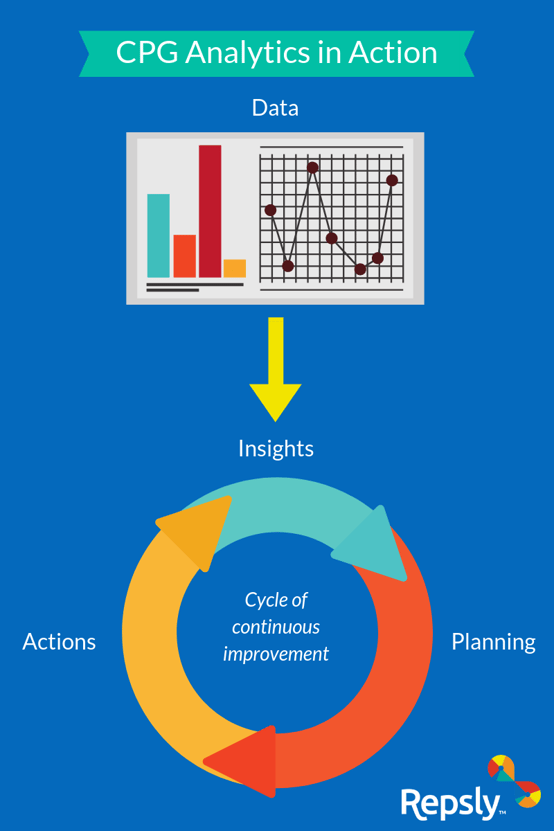Without CPG analytics at the center of a business strategy, business decisions will be made on little more than a hunch -- and in today’s competitive market, a hunch simply doesn’t cut it. Top performing brands take a data-driven approach to their businesses and identify insights and trends to inform business decisions. A data-driven company leverages analytics to create a cycle of continuous improvement in the field, allowing them to constantly evolve and adapt.
How can CPG analytics help you grow your brand? What tools and tricks are out there to increase your facings and market share? Read on to find out.
CPG Analytics: Explained
Before we get into the nitty-gritty, let’s explain what the term “CPG analytics” refers to. It is one thing to track data, and another to analyze it. CPG analytics help brands take the data they are collecting and turn it into useful information by analyzing it and spotting trends. Think of it this way: data are the different points on a graph. Analytics are the insights you get from studying that graph.
Once you’ve analyzed your data and gathered your insights, the next step is to plug that information into a cycle of continuous improvement that will help grow your brand. This cycle empowers brands to take the insights they have uncovered and use them in a planning stage to then take data-driven action in the field. These three components -- insights, planning, and action -- are what make up the cycle.

Now, let’s get into a few of the ways that CPG analytics can feed your improvement cycle and maximize your brand’s performance. CPG analytics can help you...
Predict Consumer Activity and Plan Ahead
Doesn’t it make you cringe thinking about how many times you may have missed out on sales because you didn’t catch an out-of-stock in time? CPG analytics can be used as a predictive tool for brands to prevent this fumble. With a data-driven system in place, you will be aware when your stock levels at a certain retailer are decreasing so you can replenish your shelves before customers are forced to opt for a competitor’s product. Better yet, if you have a long-term analytics strategy, you’ll start to identify and understand patterns within different retailers. Consider this example:
Your cold-pressed juices have been selling great! So great, that you’ve had a few near out-of-stocks at a particular retailer. While it's nice to know your product is loved by shoppers, your sales reps, your distributor, and the store owner aren’t huge fans of the last-minute scramble to replenish.
Now, if you’re an analytics-driven CPG company, you’ll notice pretty quickly that based on the data, this certain retailer should be receiving larger orders in the first place. Next time around, you can double down and avoid out-of-stocks while keeping your partners and your customers happy. Take it a step even further by running promos and demos specific to the preferences of that store location, rewarding your customers for their unwavering loyalty. If your orange juice is selling better than your green juice, help move more of both off the shelf by offering a discount for multiple purchases.
Tell a Data Story and Gain Shelf Share
Getting your product on store shelves can be one of the hardest parts about running a CPG business. Plenty of brands, tons of competition, and only so many shelves to go around! Rather than relying on buzzwords or anecdotal testimonies, set your products apart by using data and analytics to tell data stories to retailers.
Data stories take the messaging you interpret from your analytics and make it into something easily digestible for the reader. They interpret information that may otherwise be represented through confusing graphs and charts and communicate it in a clear, less technical manner.
Data stories come in handy, especially when presenting to retailers to win facings. This is exactly how vegan cheese brand Daiya Foods has come to dominate their category. Barry Anderson, Director of U.S. Retail Sales at Daiya, told us that in their experience, “most grocery retailers don’t want to talk about vegan cheese. But once we’ve got the data to show them the incredible growth, reach, and velocity we have, it opens their eyes.”
Track KPIs and Get Closer to Your Goals
KPIs, or key performance indicators, are a set of metrics teams agree on tracking to measure how well they are working towards their goals. They are quantifiable, which means they become data that can be analyzed as part of a comprehensive strategy of improvement. KPIs can focus on things like sales volume and growth, rep visits over a period of time, new and churned accounts, and more.
KPI data will provide insights as to what you can address in the field to improve your team’s performance. When deciding which KPIs to measure, be sure to pick S.M.A.R.T. indicators - Specific, Measurable, Actionable, Relevant, and Timely. Once you have tracked your KPIs for some time, analyze them and look for where you and your team excelled and where you fell short. Use the information you gather to feed your cycle of continuous improvement and take actions that deliver the highest impacts.
Not sure where to start with KPIs? Check out our free toolkit!
As we can see, CPG analytics can provide brands with the valuable insights they simply wouldn’t have otherwise. Using CPG analytics to grow your business turns the lights on for you when other brands are just taking a shot in the dark, while engaging in a cycle of continuous improvement gives you better aim. With both of them together, soon enough, you will be hitting all of your targets, no problem!



.png?width=480&height=252&name=PRESS%20RELEASE-2%20(4).png)

